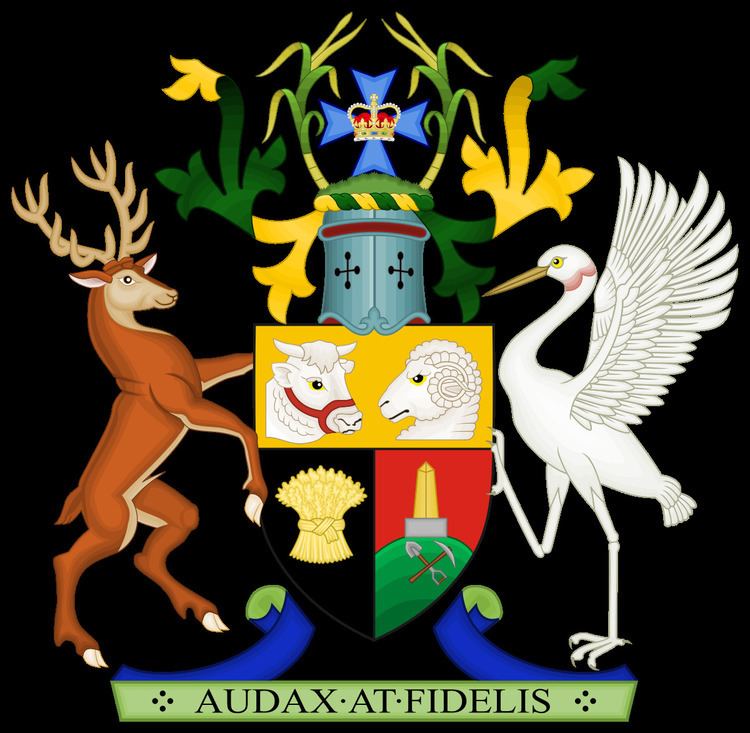Australian state Queensland Meeting place Parliament House | Main organ Cabinet of Queensland | |
 | ||
Formation 1859 as responsible Colonial government;
1901 as an Australian state Legislature Parliament of Queensland;
Legislative Assembly of Queensland | ||
The Government of Queensland, also referred to as the Queensland Government, is the Australian state democratic administrative authority of Queensland. The Government of Queensland, a parliamentary constitutional monarchy, was formed in 1859 as prescribed in its Constitution, as amended from time to time. Since the Federation of Australia in 1901, Queensland has been a state of the Commonwealth of Australia, and the Constitution of Australia regulates its relationship with the Commonwealth. Under the Australian Constitution, Queensland ceded legislative and judicial supremacy to the Commonwealth, but retained powers in all matters not in conflict with the Commonwealth. Key state government offices are located at 1 William Street in the Brisbane central business district.
Contents
Executive and judicial powers
The Government of Queensland operates under the Westminster system, a form of parliamentary government based on the model of the United Kingdom. The Governor of Queensland, as the representative of the Monarch, holds nominal power, although in practice only performs ceremonial duties. The Parliament of Queensland holds legislative power, while executive power lies with the Premier and Cabinet, and judicial power is exercised by a system of courts and tribunals.
The Parliament of Queensland is the state's legislature. It consists of the Monarch (represented by the Governor), and a single chamber; the Legislative Assembly. Queensland is the only Australian state with a unicameral parliament after a second chamber, the Legislative Council, was abolished in 1922.
The Legislative Assembly has 89 members; one representing each electoral district in Queensland. Elections for the Legislative Assembly are held approximately every three years.
The Cabinet of Queensland is the government's chief policy-making organ, and consists of the Premier and all ministers.
Queensland government agencies
The Queensland Government delivers services, determines policy and regulations, including legal interpretation, by a number of agencies grouped under areas of portfolio responsibility. Each portfolio is led by a government minister who is a member of the Parliament. As of April 2016 there were nineteen lead agencies, called government departments, that consist of:
A range of other agencies support the functions of these departments.
Judiciary
The judiciary of Queensland consists of the Magistrates Court, the District Court, and the Supreme Court, as well as a number of smaller courts and tribunals. The Chief Justice of Queensland is the state's most senior judicial officer.
Magistrates Court
The Magistrates Court is the lowest tier of the judicial hierarchy of Queensland. The court's criminal jurisdiction covers summary offences, and indictable offences which may be heard summarily, but all criminal proceedings in Queensland begin in the Magistrates Court, even if they are not within this jurisdiction. For charges beyond its jurisdiction, the court conducts committal hearings in which the presiding magistrate decides, based on the strength of the evidence, whether to refer the matter to a higher court or dismiss it. The court's civil jurisdiction covers matters in which the amount in dispute is less than or equal to $150,000. Appeals against decisions by the Magistrates Court are heard by the District Court.
District Court
The District Court is the middle tier of the judicial hierarchy of Queensland. The court has jurisdiction to hear all appeals from decisions made in the Magistrates Court. Its criminal jurisdiction covers serious indictable offences (such as armed robbery, rape, and dangerous driving). The court's civil jurisdiction covers matters in which the amount in dispute is more than $150,000 but less than or equal to $750,000. Appeals against decisions by the District Court are heard by the Court of Appeal, a division of the Supreme Court.
Supreme Court
The Supreme Court is the highest tier of the judicial hierarchy Queensland. The court has two divisions; the Trial Division and the Court of Appeal. The Trial Division's jurisdiction covers serious criminal offences (including murder and manslaughter), and civil matters involving claims of more than $750,000. The Court of Appeal's jurisdiction allows it to hear cases on appeal from the Trial Division, the District Court, and a number of other judicial tribunals in Queensland. Appeals against decisions by the Court of Appeal are heard by the High Court of Australia.
